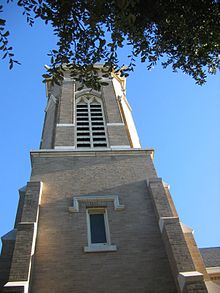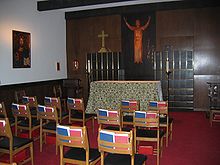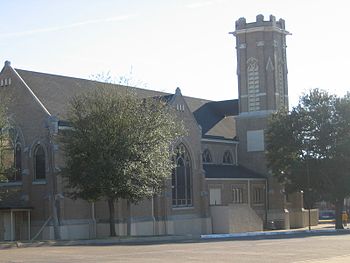- Covenant United Methodist Church
-
 The west end of the Cathedral Church of Saint Matthew in Dallas, Texas
The west end of the Cathedral Church of Saint Matthew in Dallas, Texas
Covenant United Methodist Church is a United Methodist church located in Austin, Texas, in the United States.
Contents
History
In May of 1981, at the Annual Conference of the Southwest Texas Conference of the United Method Church, the Reverend Harry G. Foster was commissioned to establish a new United Methodist congregation in northwest Austin. Rev. Foster was able to secure meeting space for the forming congregation at the Beaver Brook Day Care Center in Jollyville, Texas and began advertising that the new congregation was forming. The first worship service for the new congregation was held in the Beaver Brook Day Care Center on July 12, 1981. The name "Covenant" was officially adopted by the congregation on September 27, 1981 and the church received their Certificate of Charter from the Southwest Texas Conference on June 6, 1982.
Meeting at the day care center and using their facilities meant that some flexibility was required by the fledgling congregation. One such consideration was that the chairs that were available for the congregation to sit on during worship service were all sized for preschoolers. This lead many in the congregation, including charter members Ruth Cox and Richard Watson, to refer to the services at Beaver Brook as "Church of the little chairs".
Fortunately, the congregation's time at Beaver Brook was brief. Land was purchased at 4410 Duval Road in Austin, Texas and construction began on October 9, 1982. Work was completed in just 2 months and the first worship service was held in the new sanctuary on December 15, 1982. In 1990, a new Education Wing was added to the North (back) side of the church to provide additional classrooms and meeting space. In 2004, the church building was expanded to create a new Sanctuary and additional classrooms.
The first church service for the held in Dallas, was conducted by the Reverend George Rottenstein on May 25, 1856. The services were held on the second floor of a general store. At the time, Dallas was a town of about 400 people. The small congregation grew, and Mr Rottenstein submitted Articles of Association to the Episcopal Church for the creation of the Episcopal Church of Saint Matthew to be effective September 21, 1857. The articles were ratified at the General Convention.On July 8, 1860, a fire broke out in Dallas that consumed most of the businesses on the town square as well as the rented facilities and all church belongings and records of Saint Matthew’s. The fire has been attributed to abolitionists by several historians. When the Right Rev. Alexander Gregg, first bishop of Texas, visited Dallas in October 1860, he found no church building, no records, and only six communicants. Bishop Gregg gave assistance to the small congregation so that the parish could continue.
The parish recovered and grew such that by 1870, the parish had enough funds for the construction of its own church. Its church bell was added later that same year. During Reconstruction, professional gamblers paid for the first rectory.
 The cathedral bell is called the Great Matthew. It was cast in 1870. In 1888, it was recast to its present size of 1500 pounds. Because of its immense size, when the cathedral moved to its present location, the small bell tower could not hold the immense bell. The Great Matthew was placed on a bell-cot. On one side of the bell-cot] is a plaque from 1899 marking the celebration of the 25th anniversary of the cathedral. Embedded on the other side of the cathedral is the cornerstone from the previous cathedral building constructed in 1893.
The cathedral bell is called the Great Matthew. It was cast in 1870. In 1888, it was recast to its present size of 1500 pounds. Because of its immense size, when the cathedral moved to its present location, the small bell tower could not hold the immense bell. The Great Matthew was placed on a bell-cot. On one side of the bell-cot] is a plaque from 1899 marking the celebration of the 25th anniversary of the cathedral. Embedded on the other side of the cathedral is the cornerstone from the previous cathedral building constructed in 1893.
As the city grew, it became necessary to move the church to another location. In 1877, it was put on heavy rollers pulled by oxen. However, the building collapsed. Parishioners, with the help of citizens, carried the boards by hand to the new location and another church was built.
The Diocese of the Missionary District of Northern Texas was formed, led by the Right Reverend Alexander Garrett, and on February 2, 1875, Bishop Garrett named Dallas his see city and Saint Matthew’s as his cathedral church. On December 20, 1895, the Diocese of the Missionary District of Northern Texas became the Diocese of Dallas.
In 1893, a fine new stone cathedral was constructed on the corner of Elm and Lamar. But within a few years, the growing industrious city life encroached. Train tracks were laid close by, and one of the train services had noisy steam engines arriving at a nearby station at noon each Sunday. By the late 1920s, the Cathedral Church of Saint Matthew decided to relocate the church to a temporary location and then assess the possibilities.
At that same time, Saint Mary’s Episcopal College for Women was facing substantial financial struggles as new schools opened in the city. Bishop Garrett closed his beloved school and purchased the property for the cathedral. The cathedral moved into its current location in July 1929. The Wall Street Crash of 1929 occurred in October, and the cathedral, like its parishioners and citizens of Dallas, suffered greatly. The cathedral was unable to afford another move, and so the temporary move to Saint Mary’s Episcopal College for Women became permanent.
The cathedral today
The Cathedral Church of Saint Matthew remains at the former location of Saint Mary’s Episcopal College for Women. The tree-lined college campus is now the cathedral close and the dormitories, class rooms, and offices are still in use.
The cathedral has a beautiful collection of stained-glass windows dating from the late 1800s. Many of them were installed in the 1970s. These impressive windows include the Nativity, the Resurrection, the Stations of the Cross, the cathedral’s patron saint Saint Matthew, the sacraments, and the founding fathers of the church. Because the history of the church is in Texas, some of the windows contain interesting images, such as cowboys, Native Americans, and a stagecoach.
 The shield of the Cathedral Church of Saint Matthew in Dallas is a gold cross on a red background. Above the shield on the left are the bishop’s crosier and miter, indicating the church’s status as cathedral. The star on the upper left of the shield represents Texas, and the crossed keys on the upper right represent Saint Peter, which also represents cathedral status. On the lower left is the Great Matthew — the bell that was installed at the church in 1870, and on the right are three bags of gold which represent Saint Matthew. In the center of the shield, the Bible is opened to the Book of Saint Matthew. On the ribbon below the shield is the Latin phrase Pro Populo Dei which means “For the People of God.”
The shield of the Cathedral Church of Saint Matthew in Dallas is a gold cross on a red background. Above the shield on the left are the bishop’s crosier and miter, indicating the church’s status as cathedral. The star on the upper left of the shield represents Texas, and the crossed keys on the upper right represent Saint Peter, which also represents cathedral status. On the lower left is the Great Matthew — the bell that was installed at the church in 1870, and on the right are three bags of gold which represent Saint Matthew. In the center of the shield, the Bible is opened to the Book of Saint Matthew. On the ribbon below the shield is the Latin phrase Pro Populo Dei which means “For the People of God.”
In addition, there is a magnificent collection of paintings dating from the Victorian era. Some of these paintings were gifts to Saint Mary’s Episcopal College for Women, so it is not surprising to find the subject matter of many of the paintings to be Saint Mary.
Schools within the Cathedral
The cathedral contains The Right Reverend James M. Stanton Center for Ministry Formation , whose primary mission is to serve people who feel called to the Diaconate; both to aid them in their discernment process and to provide the necessary theological training for possible ordination as deacons. The Cathedral Center is a place where deacons-in-training can be part of a community, attend graduate-level classes, and experience spiritual growth.
The cathedral also offers its facilities to various groups in the diocese and community for a variety of instruction. Not all classes are of a religious nature; classes are also offered for people preparing to take the General Educational Development Test, sign language, and more.
Leadership
The cathedral is the seat of the Bishop of Dallas. The Right Reverend James Monte Stanton was consecrated the sixth bishop of the Episcopal Diocese of Dallas March 6, 1993.
As of Easter 2006, the cathedral's vestry called the Very Rev. Kevin E Martin to be the new dean.
The cathedral usually has several assisting priests and deacons, many of whom are canons of the cathedral.
There are several groups and guilds headed by lay people.
There is a large guild of cathedral vergers. The primary responsibility of the cathedral vergers is to assist with worship services. Vergers work with acolytes and altar guild to ensure that the church is ready for worship services. After services, vergers assist with returning vestments and vessels to their proper places. The cathedral usually has one to three vergers at regular worship services. Vergers also assist with tours and special events at the cathedral. The cathedral provides facilities from time to time for the Vergers Guild of the Diocese of Dallas to conduct training, workshops, and retreats.
Worship
The church is part of the Episcopal Church in the United States of America and worship services are based on the 1979 Book of Common Prayer. There are a number of important worship services, such as the Solemn Mass of Easter and Midnight Mass at Christmas. While most of the services are High Church other services are more Broad church in style. As an inner city church, its congregation and services are quite diverse.
Incense is used at most of the principal feasts of the church year.
Music is an important element at the cathedral, which boasts a pipe organ with an estimated 3,000 pipes. The cathedral hosts an annual festival of music with renowned musicians. The current director of music and principal organist is John Emory Bush, an alumnus of the Juilliard School and music director of the San Francisco Concert Chorale and Valley Concert Chorale. A regular featured guest organist is James Diaz, winner of the 2000 Dallas International Organ Competition and choirmaster at St Michael and All Angels Episcopal Church (one of the largest in the nation).
On Sunday, there are three worship services with Mass held at the cathedral. The third service of the day is conducted in Spanish.
Most weekday services are held in the oratory, with Mass each morning, and Evening Prayer from the Daily Office each evening. Noonday Prayer is offered on the last Saturday of each month.
Twice each month, Chanted Vespers is held in the cathedral.
In addition, from time to time, the cathedral hosts Taizé services. People from many places and many denominations attend these services of devotion and meditation. Taizé services at the cathedral are led by lay people.
The cathedral is also host of several diocesan services and events including ordinations, confirmations, conventions, annual vergers’ conferences as well as a variety of retreats for religious and civic groups.
In addition, the cathedral hosts for the community a number of civic events each year, including plays, dances, festivals, tea parties and summer camps for youth.
Diversity
The cathedral is inner city, and the neighborhood continuously evolves. A large Hispanic community has grown in the area for the past several decades. In addition, developers are purchasing portions of land in the area and building expensive apartment and condominium complexes. The cathedral close is not far from downtown, and sits in this transitional neighborhood that is half-way between two expensive neighborhoods. As a result, there is a great range of population characteristics evident in the congregation. The cathedral is known for its offerings to a wide range of people.
Architecture
The architectural style of the church building is Gothic, marked, among other things, by pointed arches, flying buttresses, vaulted ceilings, stained-glass windows, stone-carved decorations, and a bell tower. Cornerstones, plaques, and stained-glass windows from the earlier locations of the cathedral are also incorporated around the cathedral close.
The architectural style of the oratory is modern. There is a columbarium in the oratory of the cathedral.
The Great Hall holds a large parish hall, stage and two industrial kitchens. It was built in 1955, and its architectural style is 1950s modern.
Architectural Interests
Saint Mary’s Episcopal College for Women had a chapel constructed in 1907. The chapel was designed in the traditional shape of a cross. In 1929, the chapel was enlarged to hold the large congregation of the cathedral, changing the traditional cross configuration into a rectangle.
The central stained-glass window of Saint Mary’s Episcopal College for Women is the Nativity scene, and on each side of it are windows relating to patron saints of women. Rather than replace these windows with the cathedral’s patron Saint Matthew, a stained-glass window of Saint Matthew was installed in the south transept.
 It is traditional for a bell tower to be at the corner of a church structure. The expansion of the nave in 1929 extended the building beyond the bell tower, so that today, the tower is on the side of the building rather than the corner. The interior of the three-story bell tower is very small and narrow. Its ladder and openings permit only a person of small stature to enter. The bell of the cathedral was too large and heavy to be put into the tower, so when it was moved to the cathedral, it was placed on a bell-cot.
It is traditional for a bell tower to be at the corner of a church structure. The expansion of the nave in 1929 extended the building beyond the bell tower, so that today, the tower is on the side of the building rather than the corner. The interior of the three-story bell tower is very small and narrow. Its ladder and openings permit only a person of small stature to enter. The bell of the cathedral was too large and heavy to be put into the tower, so when it was moved to the cathedral, it was placed on a bell-cot.
Sources
Terwilliger Library & Archives at the Cathedral Church of Saint Matthew, Dallas, Texas.
- For information listed on the historical marker see the entry in the Texas Historic Sites Atlas of the Texas Historical Commission.
- For historical information on the City of Dallas, see The Handbook of Texas Online, Dallas.
- For historical information on the Episcopal Diocese of Dallas, see the Episcopal Diocese of Dallas website.
External links
Categories:- Episcopal cathedrals in the United States
- Episcopal churches in Texas
- National Register of Historic Places in Texas
- Religion in Dallas, Texas
- Churches in Dallas-Fort Worth, Texas
Wikimedia Foundation. 2010.





